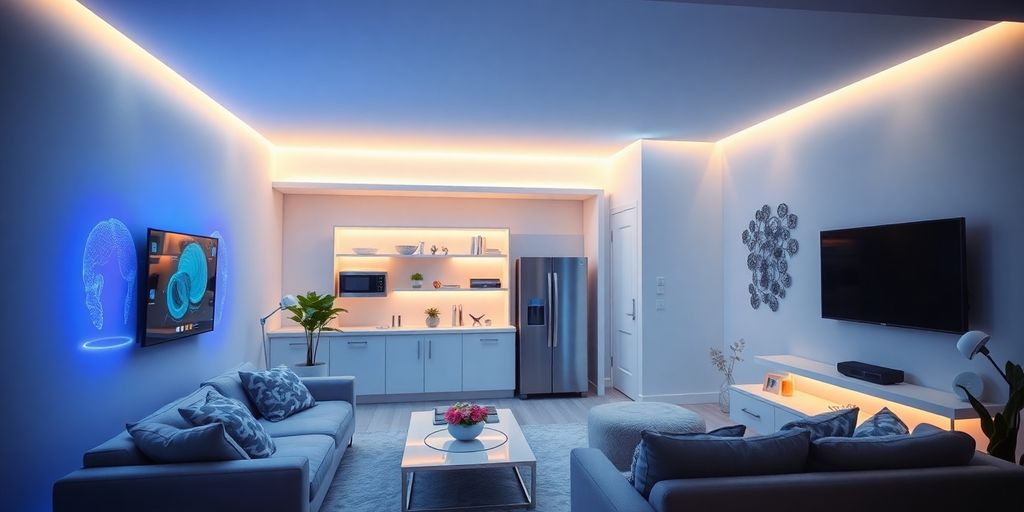So, I’ve been thinking about how cool it would be to control my entire house with just my mind. Like, no more fumbling for the light switch or trying to remember where I left the TV remote. Turns out, this isn’t just sci-fi anymore. With the best neural interface devices for home, it’s becoming a reality. Imagine just thinking about turning on the lights, and boom, it happens. Let’s dive into how these gadgets are transforming our homes into something out of a futuristic movie.
Key Takeaways
- Neural interfaces are making it possible to control home devices with your mind.
- These devices are especially helpful for people with mobility issues.
- Privacy and security are big concerns with this new tech.
- AI integration with neural interfaces is leading to more personalized home experiences.
- Energy efficiency is getting a boost from smart neural tech.
Revolutionizing Home Automation with Neural Interfaces

Neural interfaces are like the new cool kid on the block when it comes to home automation. These gadgets are mixing up our usual tech scene by letting us control our homes with just our minds. Imagine this: you’re chilling on the couch and want to dim the lights or adjust the thermostat. With brain-controlled home automation systems, you could do that without lifting a finger. It’s like something straight out of a sci-fi movie.
Understanding Neural Interface Technology
So, what exactly are these neural interfaces? They’re basically devices that hook up with your nervous system. Some are implanted in your brain, while others are more like wearables. These devices can pick up on your brain’s signals and use them to control stuff around the house. Think of it as having a remote control in your head. The best neural interface devices for home automation are getting smarter and more intuitive by the day.
Benefits of Neural Interfaces in Smart Homes
- Hands-Free Control: Forget about remotes or voice commands. Just think, and it’s done. This is a game-changer, especially for folks with mobility issues.
- Personalized Settings: Your home can learn your habits and adjust settings based on your preferences. It’s like having a personal assistant that knows you better than you know yourself.
- Seamless Integration: These interfaces work with existing smart home devices, making the transition smooth and hassle-free.
Challenges and Considerations
But hey, it’s not all rainbows and sunshine. There are some bumps in the road too.
- Privacy Concerns: With your brain hooked up to the internet, there’s always a worry about who might be snooping.
- Technical Hurdles: Making sure these devices work flawlessly is a big ask. There’s a lot of tech to get right.
- Cost: Right now, these systems aren’t cheap. It’s going to take some time before they’re accessible to everyone.
Neural interfaces are opening doors to a new world of home automation. While the tech is still growing, the potential is huge. Imagine a future where your home reacts to your thoughts without a single spoken word. It’s closer than you might think.
Neuralink’s Impact on Smart Home Control
Imagine walking into your living room and adjusting the lights with just a thought. Sounds like sci-fi, right? But with Neuralink’s brain-computer interface for smart home control, this could soon be your reality. Neuralink is working on tech that lets you control your smart home with thoughts, making life easier and more accessible for everyone. Smart home control without lifting a finger, literally!
Here’s how it might work:
- Brain Signals: Neuralink’s device reads your neural signals.
- Device Communication: These signals are sent wirelessly to your smart devices.
- Action Execution: Your devices respond to your thoughts.
This could be game-changing for folks with mobility issues, giving them independence in their own homes. Plus, it takes convenience to a whole new level.
Neuralink’s neural interface smart home integration isn’t just about showing off cool tech; it’s about making life better for everyone. Think about how much easier it would be for someone with limited mobility to control their environment. No more fumbling with remotes or voice commands that don’t quite get it right. Just pure, direct interaction.
Here are some potential benefits:
- Hands-Free Operation: No need to physically interact with devices.
- Instant Response: Devices react instantly to your thoughts.
- Personalized Settings: Your home learns your preferences over time.
This tech could redefine “user-friendly,” making smart homes truly accessible to all.
Of course, with all this tech, there are some big questions about privacy and security. What happens if someone hacks into your brain signals? It’s a bit scary to think about. Neuralink and other companies will need to tackle these issues head-on to ensure your data—and your thoughts—stay safe.
Consider these challenges:
- Data Protection: Ensuring your brain data is secure.
- Unauthorized Access: Preventing unwanted access to your neural signals.
- Ethical Considerations: Balancing tech advancements with privacy rights.
As we move closer to this futuristic way of living, these concerns need addressing to make sure everyone can enjoy a safe and secure smart home experience.
AI Integration with Neural Interfaces

AI-Powered Personalization
Alright, so imagine your home just knows what you want, like magic. With AI and neural interfaces, or brain-machine interface tech, this isn’t just sci-fi anymore. BCI devices can read your brain signals and help AI systems learn what you like or need without you lifting a finger. Think of it as your home adjusting the lights or temperature based on your mood or even playing your favorite tunes when you’re feeling down. It’s like having a personal assistant who gets you, but without the awkward small talk.
Seamless Interaction with AI Assistants
Now, let’s talk about having a chat with your AI assistants. With brain interface tech, you don’t need to shout across the room to get Alexa or Google to do something. You just think it, and bam, it happens. This is especially handy if you’ve got your hands full or if voice commands aren’t your thing. It’s like having your thoughts directly connected to your devices, making interactions smoother and more natural.
Future Prospects of AI and Neural Interfaces
Looking ahead, the combo of AI and neural implants could make our homes smarter and more intuitive than ever. We’re talking about homes that can anticipate your needs before you even know them yourself. It’s not just about convenience, but also about creating spaces that adapt to us, making life a bit easier. Sure, there are challenges, like making sure our brain data is kept secure, but the potential benefits are huge. Imagine a world where your home is truly in sync with you, thanks to brain signal processing and AI.
Energy Efficiency and Sustainability through Neural Interfaces

Optimizing Energy Consumption
Neural technology is stepping into the smart home scene, promising to change how we use energy. With neural control systems, your home can adjust energy usage based on your habits. Imagine lights dimming when you relax or heating turning down when you leave a room. Neural signals could make your home smarter and more efficient.
Here’s a quick look at how this might work:
- Automatic Adjustments: Neural systems can tweak your home’s settings without you lifting a finger.
- Real-time Monitoring: Keep an eye on energy use and make changes on the fly.
- Predictive Management: Anticipate needs and adjust settings before you even realize you need it.
Promoting Sustainable Living Practices
Neurotechnology isn’t just about comfort; it’s also about living greener. By using neural signals to manage devices, you can cut down on unnecessary energy use. This tech helps make sustainable choices easier and more intuitive.
- Smart Scheduling: Plan your energy use around peak times to save money and resources.
- Eco-friendly Alerts: Get notified if you’re using too much energy and need to cut back.
- Integrated Systems: Combine neural interfaces with existing smart home tech for a seamless experience.
With neural interfaces, sustainable living becomes a natural part of daily life, making it easier to do your part for the planet.
AI and Neural Interfaces for Eco-Friendly Homes
The future of eco-friendly homes lies in the blend of AI and neural interfaces. These technologies work together to create homes that are not just smart, but also kind to the environment.
- AI-Powered Insights: Use AI to analyze neural data and suggest energy-saving tips.
- Adaptive Learning: Systems learn your habits and optimize energy use accordingly.
- Collaborative Networks: Connect with other smart homes to share and learn best practices.
By integrating efficiency in AI deployment, homes can become more sustainable, reducing the strain on our planet’s resources. Neural technology isn’t just a glimpse into the future; it’s a step toward a more sustainable tomorrow.
Enhancing Home Safety with Neural Interfaces
Immediate Emergency Responses
Imagine this: you’re in a pinch, and you need help fast. With neural interfaces, your home can act right away. Neural feedback lets you trigger alarms or call emergency services just by thinking about it. No fumbling for your phone or yelling for help. It’s like having a superhero on standby, ready to jump into action when things get dicey.
Integration with Security Systems
Neural interfaces can hook up with your home’s security gadgets. We’re talking cameras, alarms, and locks that you can control with your mind. You could lock doors or activate security cameras without lifting a finger. Plus, these systems could learn your patterns, knowing when to lock up or light up the house, making your place safer without you even trying.
Potential for Reducing Response Times
Every second counts in an emergency. Neural interfaces might cut down the time it takes to get help. By sending signals straight from your brain, these systems could alert authorities quicker than ever.
With neural feedback, the future of home safety looks promising. It’s like having a direct line from your brain to your home’s security system, making sure help is just a thought away.
The Future of Smart Home Entertainment
AI-Driven Personalization
Imagine your TV knowing exactly what you want to watch before you even sit down. That’s where smart home automation is heading with AI. These systems learn your habits and preferences, serving up content that’s just right for you. It’s like having a personal assistant who knows your taste better than your best friend. You get recommendations for movies, shows, or music based on your past choices. It’s not just about convenience; it’s about creating a viewing experience that’s tailored just for you.
Voice and Thought-Controlled Media
Gone are the days of fumbling for the remote. With advancements in neural interfaces, you might soon be able to control your entire entertainment setup with just a thought or a simple voice command. This tech is making smart home automation feel even smarter. Imagine telling your TV to “play my favorite playlist” or thinking about watching a movie and having it start automatically. It’s a game-changer for accessibility, making it easier for everyone to enjoy their media without lifting a finger.
Immersive Experiences with Neural Interfaces
Neural interfaces are set to revolutionize how we experience entertainment at home. We’re talking about fully immersive experiences that make you feel like you’re part of the action. Whether it’s gaming or watching a movie, these interfaces can provide sensory feedback that pulls you deeper into the story. This isn’t just watching TV; it’s stepping into a new world. As these technologies develop, the line between virtual and reality will blur, offering experiences that are more engaging than ever before.
The future of entertainment in smart homes is not just about watching or listening; it’s about experiencing. With AI and neural interfaces, our homes are becoming more than just places to live—they’re becoming interactive environments that respond to our every whim.
Building Inclusive Smart Homes with Neural Technology

Accessibility for All Users
Creating smart homes that everyone can use, no matter their abilities, is super important. Neural technology is stepping up to the plate here, making it easier for people with different needs to control their homes with just their minds. Imagine adjusting the lights or the thermostat just by thinking about it! This kind of tech can really make a difference for folks who might have trouble moving around or using their hands. It’s all about making life a bit easier and more comfortable for everyone.
Inclusivity in Smart Home Design
When designing smart homes, it’s crucial to think about everyone who might live there. This means considering different needs and abilities from the get-go. Neural interfaces can help by offering new ways to interact with home devices, like thought-controlled systems that don’t require any physical effort. This approach not only opens up possibilities for people with disabilities but also makes everyday tasks simpler for everyone.
Empowering Individuals with Disabilities
Neural technology can be a game-changer for people with disabilities. By allowing direct control of home systems through brain signals, it provides a level of independence that wasn’t possible before. This means that someone who might have relied on others for help can now manage things on their own, like locking doors or changing TV channels. It’s about giving people the power to live their lives on their own terms, which is pretty amazing.
Neural technology is paving the way for more inclusive living spaces, offering everyone the chance to enjoy the benefits of a smart home. As this tech continues to evolve, the possibilities are endless, making our homes more welcoming and adaptable to all.
Wrapping It Up
So, there you have it. Neural interfaces are not just some sci-fi fantasy anymore. They’re here, and they’re changing the way we think about our homes. Imagine just thinking about turning on the lights or adjusting the thermostat, and it happens. That’s the kind of future we’re looking at. Sure, there are some hurdles to jump over, like privacy and security, but the potential is huge. Whether it’s making life easier for folks with mobility issues or just adding a cool factor to your home, neural interfaces are set to transform our living spaces. It’s an exciting time to be alive, and who knows? Maybe in a few years, we’ll all be controlling our homes with just a thought. Let’s see where this journey takes us.
Frequently Asked Questions
What are neural interfaces?
Neural interfaces are tools that connect the human brain with computers, letting you control devices with your thoughts.
How can neural interfaces help in smart homes?
They allow you to control smart home devices like lights and thermostats just by thinking, making life easier, especially for people with movement challenges.
What is Neuralink?
Neuralink is a company that makes brain devices to help control things like computers and smart home gadgets using your mind.
Are neural interfaces safe to use?
While they are new, scientists are working to make them safe. It’s important to follow updates from experts on safety.
Can neural interfaces save energy at home?
Yes, they can help smart homes use less energy by learning your habits and adjusting devices automatically.
Will neural interfaces be available for everyone soon?
They are still being developed and tested, so it might take some time before everyone can use them in their homes.



